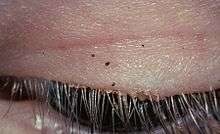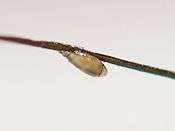Crab louse
The crab louse or pubic louse (Pthirus pubis) is an insect that is an obligate ectoparasite of humans, feeding exclusively on blood.[1] The crab louse usually is found in the person's pubic hair. Although the louse cannot jump, it can also live in other areas of the body that are covered with coarse hair, such as the eyelashes.[2][3] It is of the order Psocodea.
| Crab louse | |
|---|---|
_Female%2C_from_a_human_host.jpg) | |
| Scientific classification | |
| Kingdom: | |
| Phylum: | |
| Class: | |
| Order: | |
| Suborder: | |
| Family: | |
| Genus: | |
| Species: | P. pubis |
| Binomial name | |
| Pthirus pubis | |
| Synonyms | |
|
Pediculus pubis Linnaeus, 1758 | |
Humans are the only known hosts of the crab louse, although a closely related species, Pthirus gorillae, infects gorilla populations. The human parasite diverged from Pthirus gorillae approximately 3.3 million years ago.[4] It is more distantly related to the genus Pediculus, which contains the human head and body lice and a louse that affects chimpanzees and bonobos.
Naming
Infestation with crab lice is also called phthiriasis or phthiriasis pubis. The disease (like the name of the order to which the louse belongs, Phthiraptera) is spelled with phth, but the scientific name of the louse, Pthirus pubis, is spelled with pth, despite this being based on a misspelling that was nevertheless fixed as the official spelling in 1958.[5]
Description
An adult crab louse is about 1.3–2 mm long (slightly smaller than the body louse and head louse), and can be distinguished from those other species by its almost round body. Another distinguishing feature is that the rearmost two pairs of legs of a crab louse are much thicker than the front legs and have large claws.[6]
Life cycle
The eggs of the crab louse are laid usually on the coarse hairs of the genital and perianal regions of the human body. The female lays about three eggs a day. The eggs take 6–8 days to hatch, and there are three nymphal stages which together take 10–17 days before the adult develops, making a total life cycle from egg to adult of 16–25 days. Adults live for up to 30 days.[6] Crab lice feed exclusively on blood, and take a blood meal 4–5 times daily. Adults are 1.5–2.0 mm long and flattened. They are much broader in comparison to head and body lice. Adults are found only on the human host and require human blood to survive. If adults are forced off the host, they will die within 24–48 hours without a blood feeding. Pubic lice are transmitted from person to person most-commonly via sexual contact, although fomites (bedding, clothing) may play a minor role in their transmission.[7]
Infestation of humans

Infestations of crab lice are known as pediculosis pubis or phthiriasis pubis (which, unlike the generic name of the louse, is spelled with a phth). Infestation of the eyelashes is referred to as pediculosis ciliaris or phthiriasis palpebrarum.[8]
The main symptom of infestation with crab lice is itching, usually in the pubic-hair area, resulting from hypersensitivity to louse saliva, which can become stronger over two or more weeks following initial infestation. In some infestations, a characteristic grey-blue or slate coloration appears (maculae caeruleae) at the feeding site, which may last for several days.

Current worldwide prevalence has been estimated at 2% of the human population, but accurate numbers are difficult to gauge because crab lice infestations are not considered a reportable condition by many governments, and many cases are self-treated or treated discreetly by primary physicians.[9]
It has been suggested that an increasing percentage of humans removing their pubic hair has led to reduced crab louse populations in some parts of the world.[10][11] Other lice that infest humans are the body louse and the head louse. The claws of these three species are adapted to attachment to specific hair diameters.[12]

Pubic lice are not known to transmit disease. Adult pubic lice are 1.1–1.8 mm in length. The pubic hair can typically host up to a dozen on average. Pubic lice typically are found attached to hair in the pubic area but sometimes are found on coarse hair elsewhere on the body (for example, eyebrows, eyelashes, beard, mustache, chest, armpits, etc.). They do not generally occur on the finer hair of the scalp.[6][13] Crab lice attach to pubic hair that is thicker than other body hair because their claws are adapted to the specific diameter of pubic hair.[14] Pubic lice infestations (pthiriasis) are usually spread through sexual contact.[14][2][3] The crab louse can travel up to 25 cm (10 in) on the body. Pubic lice infestation is found worldwide and occurs in all races and ethnic groups and in all economic levels. Pubic lice usually are spread through sexual contact and are most common in adults. Occasionally pubic lice may be spread by close personal contact or contact with articles such as clothing, bed linens, and towels that have been used by an infested person.[7][15]
Pubic lice found on the head or eyelashes of children may be an indication of sexual exposure or abuse. Pubic lice do not transmit disease; however, secondary bacterial infection can occur from scratching of the skin. They are much broader in comparison to head and body lice. Adults are found only on the human host and require human blood to survive. If adults are forced off the host, they will die within 24–48 hours without a blood feeding.[7]
Symptoms of crab louse infestation in the pubic area include itching, redness and inflammation. These symptoms cause increased blood circulation to the skin of the pubic region creating a blood-rich environment for the crab louse. Pubic lice infestation can also be diagnosed by identifying the presence of nits or eggs on the pubic hair. When clinicians find the crab louse on one family member they often request to examine other members of the family for similar symptoms of infestation. If a clinician suspects the presence of the louse, they may be able to identify the nits or eggs under magnification.[14]
References
- Rapini, Ronald P.; Bolognia, Jean L.; Jorizzo, Joseph L. (2007). Dermatology: 2-Volume Set. St. Louis: Mosby. ISBN 978-1-4160-2999-1.
- CDC (Centers for Disease Control and Prevention) (2017-05-02). "Parasites: lice". www.cdc.gov. Retrieved 2017-12-04.

- CDC (Centers for Disease Control and Prevention) (2017-05-02). "Parasites: pubic "crab" lice". www.cdc.gov. Retrieved 2017-12-04.

- Weiss RA (10 February 2009). "Apes, lice and prehistory". J Biol. 8 (2): 20. doi:10.1186/jbiol114. PMC 2687769. PMID 19232074.
- "Phthiraptera.info: Taxonomy of Human Lice". Retrieved 2019-10-23.
- Service, Mike (2012). Medical Entomology for Students (5th ed.). Cambridge: Cambridge University Press. ISBN 978-1-107-66818-8.
- CDC (Centers for Disease Control and Prevention) (2017-05-02). "Pubic "crab" lice: biology". www.cdc.gov. Retrieved 2017-12-04.

- Manjunatha NP, Jayamanne GR, Desai SP, Moss TR, Lalik J, Woodland A. Pediculosis pubis: presentation to ophthalmologist as phthriasis palpebrarum associated with corneal epithelial keratitis. Int. J. STD AIDS 2006; 17: 424–426
- Anderson AL, Chaney E (February 2009). "Pubic lice (Pthirus pubis): history, biology and treatment vs. knowledge and beliefs of US college students". Int J Environ Res Public Health. 6 (2): 592–600. doi:10.3390/ijerph6020592. PMC 2672365. PMID 19440402.
- Armstrong, N. R.; Wilson, J. D. (2006). "Did the "Brazilian" kill the pubic louse?". Sexually Transmitted Infections. 82 (3): 265–266. doi:10.1136/sti.2005.018671. PMC 2564756. PMID 16731684.
- Bloomberg: Brazilian bikini waxes make crab lice endangered species, published 13 January 2013, retrieved 14 January 2013
- Williams gynecology. Hoffman, Barbara L., Williams, J. Whitridge (John Whitridge), 1866-1931. (2nd ed.). New York: McGraw-Hill Medical. 2012. p. 90. ISBN 9780071716727. OCLC 779244257.CS1 maint: others (link)
- Nuttall, GHF (1918). "The biology of Phthirus pubis". Parasitology. 10 (3): 383–405. doi:10.1017/s0031182000003954.
- Williams gynecology. Hoffman, Barbara L., Williams, J. Whitridge (John Whitridge), 1866-1931. (2nd ed.). New York: McGraw-Hill Medical. 2012. ISBN 9780071716727. OCLC 779244257.CS1 maint: others (link)
- CDC (Centers for Disease Control and Prevention) (2017-05-02). "Pubic "crab" lice: epidemiology & risk factors". www.cdc.gov. Retrieved 2017-12-04.

External links
| Wikimedia Commons has media related to Pubic lice. |